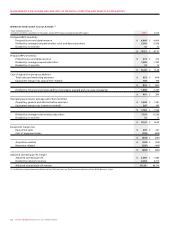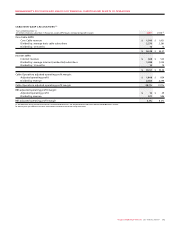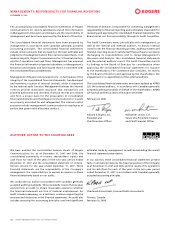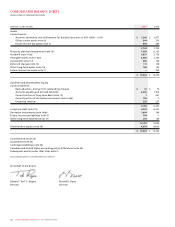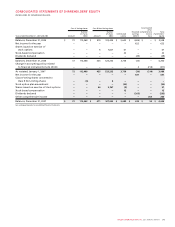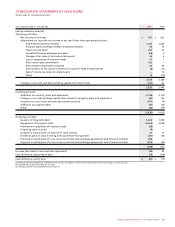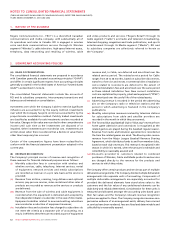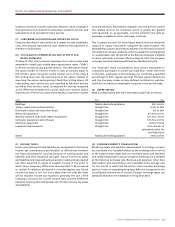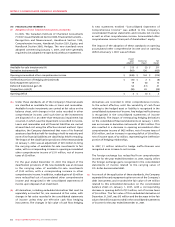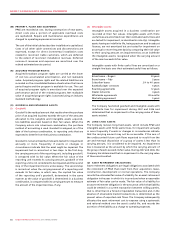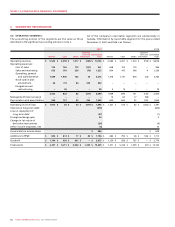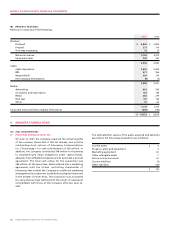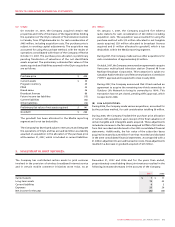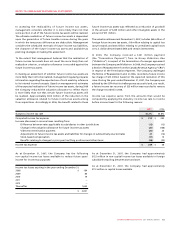Rogers 2007 Annual Report Download - page 88
Download and view the complete annual report
Please find page 88 of the 2007 Rogers annual report below. You can navigate through the pages in the report by either clicking on the pages listed below, or by using the keyword search tool below to find specific information within the annual report.
84 ROGERS COMMUNICATIONS INC. 2007 ANNUAL REPORT
NOTES TO CONSOLIDATED FINANCIAL STATEMENTS
(H) FINANCIAL INSTRUMENTS:
(i) Adoption of new financial instruments standards:
In 2005, The Canadian Institute of Chartered Accountants
(“CICA”) issued Handbook Section 3855, Financial Instruments –
Recognition and Measurement, Handbook Section 1530,
Comprehensive Income, Handbook Section 3251, Equity, and
Handbook Section 3865, Hedges. The new standards were
adopted commencing January 1, 2007, and were generally
required to be adopted retrospectively without restatement.
A new statement entitled “Consolidated Statement of
Comprehensive Income” was added to the Company’s
consolidated financial statements and includes net income
as well as other comprehensive income. Accumulated other
comprehensive income forms part of shareholders’ equity.
The impact of the adoption of these standards on opening
accumulated other comprehensive income and on opening
deficit at January 1, 2007, was as follows:
(A) Under these standards, all of the Company’s financial assets
are classified as available-for-sale or loans and receivables.
Available-for-sale investments are carried at fair value on the
balance sheet, with changes in fair value recorded in other
comprehensive income, until such time as the investments
are disposed of or an other-than-temporary impairment has
occurred, in which case the impairment is recorded in income.
Loans and receivables and all financial liabilities are carried
at amortized cost using the effective interest method. Upon
adoption, the Company determined that none of its financial
assets are classified as held-for-trading or held-to-maturity and
none of its financial liabilities are classified as held-for-trading.
The impact of the classification provisions of the new standards
on January 1, 2007, was an adjustment of $213 million to bring
the carrying value of available-for-sale investments to fair
value, with a corresponding increase in opening accumulated
other comprehensive income of $211 million, net of income
taxes of $2 million.
For the year ended December 31, 2007, the impact of the
classification provisions of the new standards was an increase
in the carrying value of available-for-sale investments
of $140 million, with a corresponding increase in other
comprehensive income. In addition, realized gains of $2 million
were reclassified out of accumulated other comprehensive
income and recognized in the consolidated statements of
income upon disposal of an investment.
(B) All derivatives, including embedded derivatives that must be
separately accounted for, are measured at fair value, with
changes in fair value recorded in the consolidated statements
of income unless they are effective cash flow hedging
instruments. The changes in fair value of cash flow hedging
derivatives are recorded in other comprehensive income,
to the extent effective, until the variability of cash flows
relating to the hedged asset or liability is recognized in the
consolidated statements of income. Any hedge ineffectiveness
is recognized in the consolidated statements of income
immediately. The impact of remeasuring hedging derivatives
on the consolidated financial statements on January 1, 2007,
was an increase in derivative instruments of $561 million. This
also resulted in a decrease in opening accumulated other
comprehensive income of $425 million, net of income taxes of
$136 million, and an increase in opening deficit of $8 million,
net of income taxes of $2 million, representing the ineffective
portion of hedging relationships.
In 2007, $1 million related to hedge ineffectiveness was
recognized as an increase to net income.
The foreign exchange loss reclassified from comprehensive
income for the year ended December 31, 2007, exactly offset
the foreign exchange gains recognized in the consolidated
statements of income related to the carrying value of
U.S. dollar denominated debt.
(C) As a result of the application of these standards, the Company
separated the early repayment option on one of the Company’s
debt instruments and recorded the fair value of $19 million
related to this embedded derivative on the consolidated
balance sheet on January 1, 2007, with a corresponding
decrease in opening deficit of $13 million, net of income taxes
of $6 million. The fair value of this embedded derivative at
December 31, 2007, was $13 million and the decrease in the fair
value of $6 million was recorded in the consolidated statements
of income for the year ended December 31, 2007.
Impact
upon Income tax Net
adoption impact impact
Available-for-sale investments (A) $ 213 $ (2) $ 211
Derivative instruments (B) (561) 136 (425)
Opening accumulated other comprehensive income $ (348) $ 134 $ (214)
Ineffective portion of hedging derivatives (B) $ (10) $ 2 $ (8)
Early repayment option (C) 19 (6) 13
Deferred transitional gain (E) 54 (17) 37
Transaction costs (F) (59) 20 (39)
Opening deficit $ 4 $ (1) $ 3


